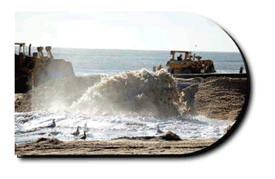The Ultimate Guide To Shore Protect Team
Table of ContentsSome Known Facts About Shore Protect Team.The Greatest Guide To Shore Protect TeamThe 30-Second Trick For Shore Protect TeamSome Of Shore Protect TeamRumored Buzz on Shore Protect TeamGet This Report about Shore Protect TeamThe Ultimate Guide To Shore Protect Team
Reduction in building worth: As the area tourism is influenced by erosion, so then is the economy. Purchasers are much less likely to search for a coastline house that might be destroyed at any minute by the upcoming flooding and disintegration emergency situation. In turn, property worth can drop immensely and affect the whole area.Whether a beach is just little and crowded or has to shut completely for the security of the ecological community and nearby buildings, this significantly impacts tourism. Consequently, regional economic climates are influenced (https://www.elephantjournal.com/profile/shoreprotectteam/). Danger of injury: The enhanced threat of flooding and structural failures causes an increased risk of injury to close-by travelers and neighborhood participants

is home to more than 84,240 miles of coastline with 41% of it exposed to the open sea. Coastal engineers are in charge of protecting the coast against modifications by reducing the destructive influences of both natural and manufactured occurrences. Shoreline stablizing is directly relevant to their work. Beachfront resorts: Because shoreline erosion effects tourism, it affects the success of waterside resorts.
The 45-Second Trick For Shore Protect Team
Coastal commercial organizations: No vacationers means no company. Coastal state parks: State parks that exist along shorelines are at danger of damages.
Difficult stablizing uses synthetic frameworks as protection to control disintegration. A lot of kinds of hard stabilization like seawalls and sheet metal are not perfect for coastline stabilization.
Unknown Facts About Shore Protect Team
There's likewise not nearly enough proof of their efficiency depending upon the sort of coastline and regional conditions. Hard stabilization strategies have a tendency to be harder to set up and do not match the natural aesthetic, protruding like an aching thumb and damaging neighborhood communities in numerous scenarios. Coastline nutrition is the process of including shed sand and debris back to beaches after erosion has taken place.
TrapBags help in the process of coastline nourishment by securing natural communities and allowing plants to expand. They're: Ecologically pleasant: You can make use of native dirt both to border and to fill up the TrapBags.

Shore Protect Team - The Facts
Easy to install: Reduce of installment indicates TrapBags can be deployed quickly in case of an emergency situation. They can likewise be mounted without any type of heavy equipment. Economical: TrapBags are perfect for both tiny and large locations of shoreline. They offer an economical remedy to cover jobs of any type of size.
Incorporated with a high building cost, this has actually caused increasing use of various other soft design seaside management options such as coastline replenishment. Seawalls are created from different materials, most generally enhanced concrete, boulders, steel, or gabions. Various other possible building materials include vinyl, wood, aluminum, fiberglass composite, and eco-friendly sandbags made of hemp and coir. The ideal seawall design counts on location-specific elements, consisting of bordering disintegration procedures. There are 3 major kinds of seawalls: upright, bent, tipped, and mounds (see table below).
Natural barriers, such as reef and mangrove forests, protect against the spread of tidal waves and the circulation of seaside waters and reduced the flooding and rise of water. A cost-benefit strategy is an effective method to establish whether a seawall is suitable and whether the advantages deserve the expense.
The 10-Minute Rule for Shore Protect Team
A seawall is a static feature which can clash with the dynamic nature of the coast and impede the exchange of sediment in between land and sea. The table below summarizes some favorable and unfavorable impacts of seawalls which can be used when comparing their efficiency with other coastal monitoring options, such as beach nourishment. [] Benefits and drawbacks of seawalls according to Short (1999) Benefits Negative aspects Lengthy term option in contrast to soft beach nutrients.

This can trigger coastlines to dissipate, providing them useless for coastline goers. Normally, seawalls can be an effective means to regulate coastal disintegration, however just if they are built well and out of materials that can endure the force of continuous wave power.
The Only Guide for Shore Protect Team
Incorporated with a high construction price, this has actually led to raising use various other soft design coastal monitoring options such as coastline replenishment. Seawalls are created from various materials, the majority of typically strengthened concrete, stones, steel, or gabions. Other possible building and construction products include plastic, wood, aluminum, fiberglass composite, and eco-friendly sandbags made of hemp and coir. The suitable seawall layout relies on location-specific facets, including bordering erosion procedures. There are three major kinds of seawalls: upright, curved, stepped, and piles (see table listed below).
Natural obstacles, such as reef and mangrove forests, prevent the spread of tidal waves and the flow of seaside waters and minimized the flood and rise of water. A cost-benefit technique is an effective method to figure out whether a seawall is ideal and whether the advantages are worth the expense.
Shore Protect Team Fundamentals Explained
A seawall is a fixed attribute which can contrast with the dynamic nature of the coast and hinder the exchange of sediment in between land and sea. Advantages and downsides of seawalls according to Short (1999) Benefits Downsides Long term solution in contrast to soft beach nourishment.

This can trigger beaches to dissipate, making them worthless for coastline goers. Usually, seawalls can be a successful method to regulate coastal erosion, but only if they are constructed well and out of products that can stand up to the force of ongoing wave power.